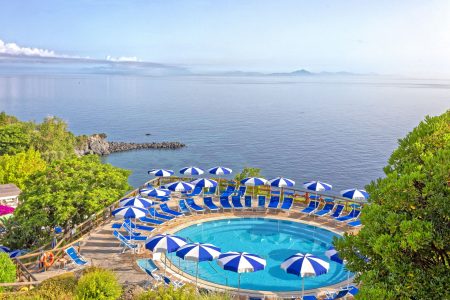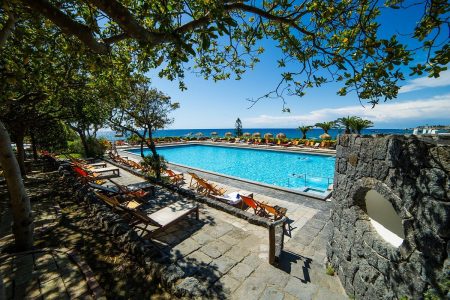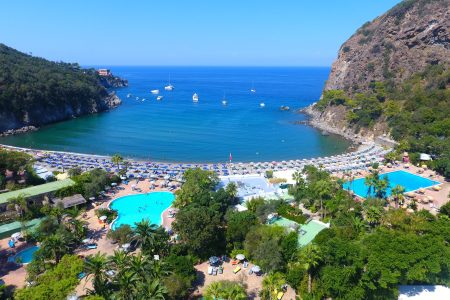The Campania is a region full of wonders waiting to be discovered, with a long coastal strip where unmissable beaches. Washed by the waters of the Tyrrhenian Sea, our region in fact has as many as four gulfs: the Gulf of Naples, where the region's capital city faces, the last part of the Gulf of Gaeta to the north, the Gulf of Salerno to the south, and part of the Gulf of Policastro.
The surprising and most famous beaches in Naples
Between the last part of the Gulf of Gaeta, which stretches between the regions of Lazio and Campania and the Gulf of Naples, where the majestic Vesuvius, the sand has a very distinctive dark color, due to the fiery lava that descended from the flanks of the volcano, which as it cooled created a black rock. This, due to exogenous agents such as wind, broke into small pieces and then fell into the sea.
The most typical example of this fascinating phenomenon is the Beach of Torre del Greco which stretches near the Neapolitan city of the same name at the foot of Mount Vesuvius. The coastal strip stretches for as much as ten kilometers between lidos and free areas, surrounded by Mediterranean scrub vegetation.
Not far from the city of Naples we find the very popular Miliscola Beach in Bacoli, on the extreme tongue of land of the Phlegrean promontory, this long coastal strip stretches from Capo Miseno to Monte di Procida, named for its proximity to the island. The beach is interspersed with free areas and equipped lidos, consisting of fine, dark sand of volcanic origin. The sea water is crystal clear and a strong blue color.
On the furthest part of the beach, where the modest tuffaceous relief of Cape Miseno, it is possible to admire small caves that are the result of sea erosion. In addition there are the ancient archaeological remains of the Roman-era cistern, the Dragonara.
Not to be missed is the Schiacchietiello beach in the reserve of the Phlegraean Fields Regional Park, consisting mainly of boulders. A little piece of paradise with a seabed to be discovered.
On the other side of the city, however, stretches the coast of Posillipo. Here, hidden among slopes and private residences, is located theGaiola Marine Protected Area. The beach can be reached on foot after a modest descent and steps, or you can catch a glimpse of it from the end of Seiano Cave. An artificial stone solarium divides two small free beaches located at either end, and stairs and a gate fence off the actual center of the marine protected area where the non-profit organization responsible for protecting the site is based.
The fine beach with volcanic sand is mixed with small pebbles, lapped by the clean, clear waters where, a little further on, the archaeological remains of the fabulous underwater park are preserved. The landscape, dominated by the high profile of Mount Vesuvius that can be seen in the distance, truly leaves one speechless. On the promontory behind, rich wild vegetation grows and birds that live in the area such as the giant gulls nest.
The wonderful beaches of the islands of Capri, Ischia and Procida
How can we not think of the wonderful beaches of the islands of Ischia, Capri and Procida? Let's start with the famous Maronti Beach in the municipality of Barano d'Ischia. A sandy tongue that stretches for about three kilometers between lidos and free beaches. The bay is surrounded by vegetation and has mixed sand lapped by thermal waters. Yes, that's right. Scattered in the sea bed are small fumaroles that look like peculiar little holes in the sand from which gaseous bubbles continually escape, making the sea a giant open-air pool of thermal water, where one can enjoy the beneficial effects of the hot, sulfurous waters.
Toward Forio d'Ischia, on the other hand, one finds the surprising Sorgeto Bay. The rocky bay was set up by placing the rocks present in the sea to form a series of small thermal pools, access to which is totally free. At one point on the beach, in fact, a spring of thermal water very high temperature that mixing with the colder sea current creates, in each pool, a specific temperature. Highly valued for its distinctiveness, the bay is frequented even in the winter months.
Finally, set on the side of the Port of Ischia, stands the unmissable Englishmen's Beach named after World War II, when it was used by the British as a mooring point on the island. The small beach can be reached by following a pebble path on the end of the pier. You will be surprised by the deep blue color of the sea given by the presence of the pebbles and volcanic sand. The waters are frequented by many fish while on the rocky part you can find sea urchins. Caves and coves here are also popular destinations for water sports lovers.
Moving on to the beautiful and lush island of Capri, on the other hand, it is necessary to make an arduous choice among the wonderful coves that characterize its coastline. The most renowned and fascinating is certainly the beautiful Marina Piccola Beach. Warm and sheltered from winds thanks to the presence of Mount Solaro. For sunbathers and sunbathers, it is advisable to arrive here in the morning hours until early afternoon when the shade of the promontory takes over.
The beach, with sand consisting of pebbles and rocks, is divided between lidos and two free areas. Considered the symbol of the island, among its waters rises the so-called Siren's Rock who, according to legend, called Ulysses with their enchanting and devilish singing.
On the island of Procida, however, we find the peculiar Chiaiolella Beach, characterized by fine dark volcanic sand mixed with a few pebbles. Protected by a rocky and verdant area that surrounds it, the beautiful beach, also known as "Ciracciello" has shallow and safe waters where even the youngest children can swim. Between the waters then rise two fascinating tufa stacks that in ancient times formed a high natural wall that physically separated this from the nearby Ciraccio Beach. From its shores it is possible to admire the view of the nearby Islet of Vivara, a protected area on the island of Ischia.
The beaches of Salerno
Salerno's coastline ranges from the beautiful beaches of the Gulf of Salerno to the southernmost tip consisting of the Cilento coast. The Gulf of Salerno is the inlet that connects at its ends Punta Campanella to Punta Licosa in the Castellabate area.
Not to be missed are villages in the Amalfi Coast and Sorrento, with their small and picturesque beaches: the Maiori Beach, the longest of those on the Amalfi coast. Of alluvial origin, it stretches for almost a kilometer between rocks and fine sand, dotted with countless bathing establishments. On the rocky part of the coast, fascinating caves and coves alternate and can only be reached by sea, such as Bellavaia Cove also called Dead Horse Beach, with the beach surrounded by a high cliff and white sand, washed by turquoise waters.
Also not to be missed are the landscapes and environments of two fjords located on the Salerno coast. The most famous rises in the heart of the Amalfi coast, the Fjord of Furore. An unspoiled landscape where high cliffs and dense vegetation provide the backdrop for a tiny pebbly beach set among the high cliffs overlooking the sea. Less well known, however, is the Crapolla Fjord to Massa Lubrense. Nearby is the beautiful beach of the Bay of Ieranto included in thePunta Campanella Marine Protected Area. It is presented with pebbles and gravel, and completely surrounded by nature. Popular with young people who go hiking on the dirt road surrounded by nature that is the only way to the beach.
In Sorrento, however, there are then the famous Queen Joan's Baths. A fjord with crystal-clear waters that shares with Furore Fjord and Crapolla Fjord a glacial origin. The formation of a fjord, in fact, occurs as a result of the presence and subsequent melting of a glacier that leaves in its place a valley with a typical "U" shape. This is filled by the sea, giving rise to picturesque landscapes. Then, in this case, what makes the site even more special is the presence of the remains of open-air Roman villas.
Descending southward, one reaches Punta Licosa, in the municipality of Castellabate, where the golden Lake Beach considered among the most beautiful in Italy. The beach, extending for about a kilometer, is accessible to all and very comfortable. It has very fine sand where the rare white sea lily grows. Hiking trails branch off from here to the nearby Cilento Park.
Leaving the Gulf of Sorrento and heading towards the Cilento coastline, we reach Palinuro where we find the Buondormire Bay, a beach with fine, golden sand, surrounded by high sheer cliffs that protect it from the wind and create a quiet, relaxing atmosphere, where the call of birds such as swifts, which nest among the rock inlets, mingles with the gentle sound of the waves. A crystal-clear sea gives snorkelers the chance to explore caves and seabeds full of life.
Toward Marina di Camerota, on the other hand, rises the cobblestone Beach of Baia degli Infreschi, surrounded by verdant nature where you can breathe in the typical smells of the Mediterranean scrub. The sea, which immediately becomes deep, is very crystal clear and limpid. Impossible to resist.
Sapri beach in the middle of the Gulf of Policastro
In the Gulf of Policastro, in the final part of the province of Salerno and on the border with Calabria, we find the last of Campania's beaches: the Sapri Beach. The shoreline is pebbly, and the many lidos alternate with spaces of free beach. The beach is part of a shoreline dotted with services, restaurants and evening hangouts. The blue sea sees a succession of rocky, verdant promontories in the background, making the place an enchanting postcard.








0 Comments